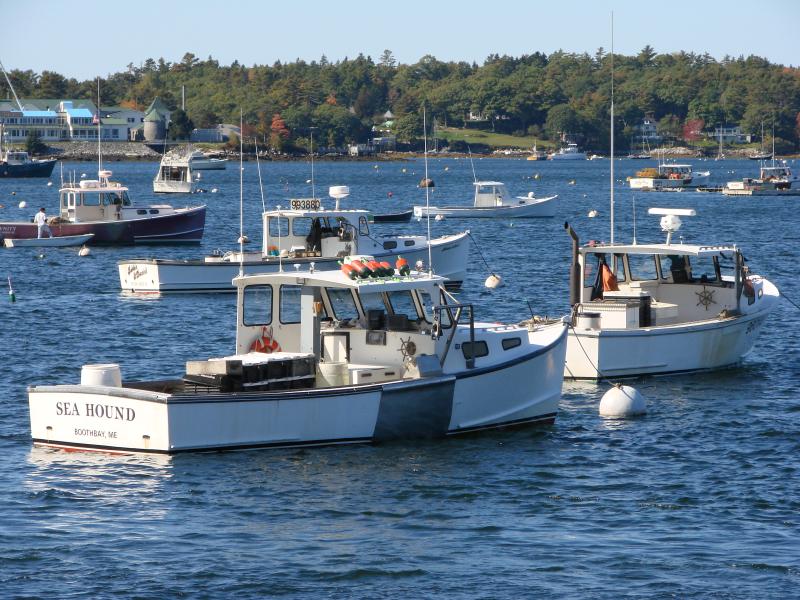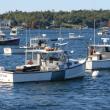Dec 15 deadline nears for lobster boat tracking devices in federal waters
Maine lobstermen who fish in federal waters have only a few weeks left until the Dec. 15 deadline to install and activate recently distributed tracking devices on their boats to comply with a regulation of the Atlantic State Marine Fisheries Commission (ASMFC).
The Particle One devices were sent by Maine’s Department of Marine Resources (DMR) with an accompanying letter of explanation. As required by the ASMFC regulation approved last year, each minute the boat is moving, the tracker will collect both the time and its position. The device will also monitor a boat when it is tied up every six hours until it moves again.
The ASMFC rule affects the 1,055 Maine lobstermen who hold permits to fish in federal waters (beyond three miles from shore), DMR Communications Director Jeff Nichols recently told the Register.
ASMFC manages coastal fisheries and is made up of three commissioners from each coastal state from Maine to Virginia. Maine’s commissioners are Patrick C. Keliher, commissioner of Maine DMR, State Rep. Allison Hepler (District 49), who chairs the House Marine Fisheries Committee and Long Island lobsterman Stephen Train.
Proponents of the regulation see it as a way to better understand where lobster fishing could harm North American right whales as well as prevent future wind farms from interfering with the lobster fishery.
Reaction to the devices is mixed, even among Maine’s commissioners.
Hepler, whose district includes Arrowsic, Georgetown, Phippsburg, West Bath and Woolwich, sees the devices as a positive step in protecting the lobster fishery which fought against aggressive restrictions over the past years.
She is in favor of the tracking effort because, as she recently told the Register, “The impact of tracking data will help us defend the fishery with regard to whales and wind.”
Hepler said the government blocked areas of federal waters (LMA1) from the sale of leases for wind farms, but there are other areas fishermen use that have not been blocked. “This electronic data will further refine where not to offer leases.” she said.
Train is a fellow ASMFC commissioner representing Maine and has been a board member of Maine Lobstermen’s Association for 16 years, is a past member of the DMR Advisory Council and has chaired the Maine Lobster Advisory Council.
Train told the Register he voted against the trackers. “I have no problem with the trackers, we are fishing with permission and they have the right, but (the rule says) they have to be on when the boat is wet.” He said the devices will track his every movement even when not in federal waters. He compared the trackers to having an “ankle bracelet” monitoring every move.
“I live on an island, and for folks on islands or peninsulas, their boat is like their car. They don’t need to know if I’m going to town for groceries.”
Asked why tracking devices were needed when extensive reporting is already required of lobster fishermen, Caitlin Starks, senior FMP coordinator for ASMFC, told the Register in a phone interview, the data currently received is not precise enough and the commission needs more detail.
Maine has the largest lobster fishery of ASMFC member states, Starks said. The commission’s 2020 stock assessment for lobster reported, “The Gulf of Maine fishery accounts for the vast majority of U.S. lobster landings, averaging 81% of the landings since 1982.”
Last year, Maine’s lobster fishery brought in $388 million in landings, “By far the most of all the state’s commercial fisheries,” according to a March DMR report.
Local lobstermen are concerned monitoring their locations infringes on their privacy, while ASMFC believes it will be useful information to have. Some lobstermen have returned the trackers to DMR. When asked, Nichols confirmed, “At present three individuals have refused and returned their tracker shipment.”
Prior to last year’s commission vote, Maine Lobstermen’s Association provided comments in opposition. The comments, provided to the Register by Kevin Kelley, MLA’s director of advancement, agree better data is needed to push back against both right whale rules and offshore wind.
But MLA believes the commission should fully implement the harvester reporting program instead. “We remain very skeptical that an electronic vessel monitoring program for the LMA 1 lobster fishery will benefit the fleet, and in fact, we worry that this program may instead cause harm,” MLA said.
Last year, Congress approved $14 million to help the lobster industry with the costs associated with protecting the right whale. Of this, about $9.5 million came to Maine, which includes $6.8 million for payments to industry members to modify lobster gear as required by federal regulations. “The cost of the trackers and three years of data for impacted industry members was $650,000,” Nichols said.
“They want to see where the boats are fishing and how that impacts the leases for wind farms,” Boothbay Harbor’s Clive Farrin told the Register. Farrin has been a lobsterman for more than 20 years and is past president of Downeast Lobstermen’s Association.
“The trackers keep track of every single move you make and where you make it. I don’t agree with it,” he said.
Troy Plummer, who holds a federal permit, said the data from devices “will enable the government to do geographic closures.” Plummer said a few proponents believe proving where the lobster fishery is in relation to right whales could exonerate the lobstermen. He also believes the data will be used for the placement of future wind farms.
He estimated he currently has to complete more than 100 reports per year. “It’s everything you do every day all year – when you left, the number of crew, the depth and number of buoys, the number of traps on the line, when you returned, the pounds caught and where they were sold.”
Nick Morley also holds a federal permit and wondered why the daily trip reports currently required are not enough for regulators. He said all the record-keeping and regulations are affecting the value of the federal permits. “Three years ago, I paid $35,000 for mine,” he said. “Now some people can’t sell theirs for $15,000.”
Taking the long view, lobstermen and regulatory agencies differ on the outcome. How the information is used may either help Maine lobstermen defend their part of the Atlantic or see it used for commercial wind farms, or both.
“I’ve spent a lot of time thinking about this,” Hepler said. “Lobster fishermen are conservationists. They don’t want to kill their industry. I’m tremendously sympathetic.”

























